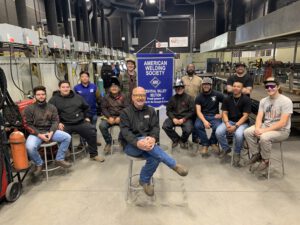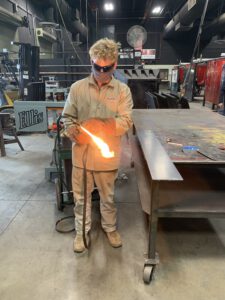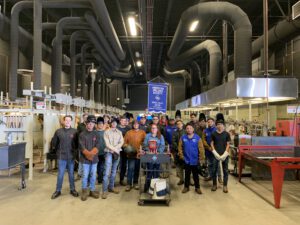
Since the end of World War II – when hundreds of thousands of US soldiers, marines, sailors and airmen returned to their homeland and the free secondary education offered to them under the GI Bill – the main emphasis for post-high school education for all students in America has been on building a pathway to higher education at universities and colleges.
An accompanying shift of national interest from farming and industry to finance and banking – another sweeping change started by US participation in WWII, with the country’s relatively safe location on the other side of the Atlantic making it an ideal place to relocate the centers of world finance – paired with a resulting decades-long fade of union power, made industry here wither to a shadow of its former glory. Venerable companies were taken over by these new US-based international financial powerhouses, their assets sold off for quick profits, their manufacturing capacity shipped literally overseas as American factories were gutted and rebuilt in foreign lands.
Building Back America
Now, 20 years into the new century, America is returning to its blue-collar roots, as many of its young people prefer to spend their lives building and making rather than sitting at a desk.
But the workers who used to pass along the skills of the industrial arts are gone too, along with many of the apprenticeship programs that made them into America’s welders, machinists and technicians. With that gap to fill, the job of making American manufacturing great again now falls not to politicians, but to educators teaching at the same institutions that led the way as the country shifted from a production economy to a service-based one.
Randy Emery is one of those educators, and he’s made it a personal goal as an instructor at the College of the Sequoias to help produce a new generation of skilled industrial workers to boost American industry. COS is the perfect place for Emery to fulfill that goal. It was there he got his own start decades ago.
“I’m a student of the program I teach,” he said. “I went through the program, then went into the industry for five years. Then I entered a plumbers and pipefitters apprenticeship.”
Local Boy Makes Good

In other words, Emery is a COS success story.
He learned a set of skills at COS that earned him a decent job, one he did for a quarter of a century before his retirement. Along the way, he began teaching nights at COS, spending 20 years instructing students in the arts of metal fabrication during his off hours.
While busy at those tasks, he says his mind wandered back to his roots, to the breaks that helped him start a productive life, and to the people in his community who wanted the same chance he had once upon a time.
“I think about that,” he said. “I like to give back.”
Emery and his wife are childless, making them, in his words, DINKs (dual-income, no kids). That fact, paired with his work as an industrial arts instructor, put Emery in a unique position to change lives in a real and substantial way, giving Valley youth a future that looks like the life he’s enjoyed.
“I know there’s a shortage of skilled-trade professions,” he said. “I’ve found a mission to give back and coach that next generation. I’m thrilled to have an influence over people’s lives in a positive way. It’s really rewarding.”
National Recognition for Emery’s Work
Emery’s dedication to his students and teaching industrial arts did not go unnoticed by the administration at COS. Seven years ago, when Emery decided he’d had enough of the daily grind in his day job, the school pounced.
“I was able to retire from the plumbing trade, and a week later I was offered a full-time job as an instructor,” he said.
A lifelong industrial worker and a part-time teacher, Emery had connections to both the world of education and the working world. Having a foot in both realms makes him ideally suited to being a link between the two. It also helps that he grew up here, and so knows and understands the struggles many of us here face due to the area’s widespread poverty.
“It was a natural fit being a native,” Emery said. “I brought education to industry, and then industry to education.”
What he really did was provide an intersection where newly made workers could network with the industries that needed their skillsets, and this year that accomplishment earned him the Howard E. Adkins Instructor Membership Award from the American Welding Society (AWS). It marks the first time a COS welding instructor has received the national honor.
‘A Perfect Fit’
During his time spent professionally brazing, welding, cutting and fitting, and soldiering water systems together, all while teaching part-time, Emery also maintained a 34-year membership in the AWS, the industries premiere welding and related industry organization since the end of World War I, and his role in that nationwide outfit is about to expand into a leadership role.
Already chair of the Central Valley chapter of the AWS, Emery is also about to become the AWS’s 22nd District director. The AWS’s 22nd District covers much of the San Joaquin and Sacramento valleys. He is also about to join the AWS’s national board of directors in January.
“I brought two worlds together. It was a perfect fit,” he said of this set of complementary circumstances. “I couldn’t have planned it better, really.”
The payoff from his participation in the AWS is no small thing for local industrial arts education.
“One of the highlights of this dual role of mine, it brings a lot of scholarship money,” Emery said. “Last year we brought in $40,000 to our district.”
Leaving a Legacy

Emery’s participation in the AWS and the recognition he’s garnered there continues to pay dividends for students hoping to work their way into a skilled manufacturing job.
“We’ve been able to ramp up our own section scholarship, and I created a scholarship of my own with AWS,” he said. “It’s districtwide, a district-wide scholarship.”
AWS put up an amount equaling a large personal donation from Emery’s own pocket to endow a fund that will help his students, now and in perpetuity, growing as time passes.
“I donated $10,000 and they matched $10,000 to create an endowment that will last forever,” he said. “It’s $1,000 a year right now. I’ll add to it as I age.”
The payoff for Emery personally is seeing his students succeed.
“I ran into one yesterday. He works for a service company, and he came out to service something on our campus,” he said. “I didn’t recognize him. He has one child and another on the way. He said getting into the industrial arts was one of the best things he’d done.”
A job that will last a lifetime is what Emery’s students want.
“I have 25 students right now. I asked how many are looking for work as soon as possible,” he said. “All of them raised their hands. They’re mostly looking for a skilled trade, a life and a career.”
While many of the participants in the industrial arts classes are typical COS students, others are not. Skilled manual labor offers an opportunity for marginalized individuals, such as ex-cons and undocumented immigrants, they likely would not otherwise have in an area rich with such people.
A Bigger, Better Future
When initially asked about his personal accomplishments, Emery demurred, wanting instead to tell the community about what’s coming next for industrial arts instruction at the College of the Sequoias.
“We have a booming story happening,” he said. “We’re getting ready to build a $27 million addition to our training center.”
The expanded facility will be at the COS Tulare College Center, and it will be home to classes covering automotive, electrical, industrial automation, welding and other speciality skill sets.
“The school has got the money to build a new facility, and we’re going to bring all the skilled trades to one complex,” Emery said.
As division chair for industrial arts, Emery had important input in the planning, and learned just this week that the expansion should be complete in time for the fall 2024 semester.
The COS industrial arts program isn’t just training workers. It is also creating a network of students, workers, instructors and people in skilled industry that will hopefully continue to grow, providing workers ready to work. Even now, Emery and his colleagues are arranging an interscholastic welding contest that will bring together top welders from three area schools to match their skills head-to-head.
And there’s money on the line, $4,000 in scholarships for the cleanest welded joints.
The event is exactly in line with the ideals Emery brings to his classes and his department.
“My mission is to communicate and to help our community,” he said.

How to avail a free member of AW’S or student I’m Filipino and 49yrs old
As a former student of yours ,
I want to say thank you for the
Time I was your student I learned a lot. Congratulations wish you the best.
I highly recommend anyone who is thinking of a carrier in welding.
This Hombrrei teaches from the Heart.